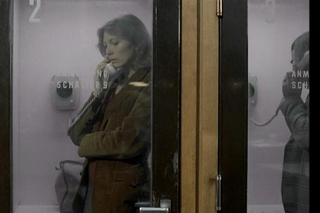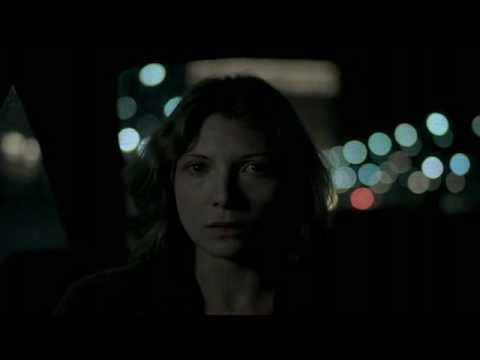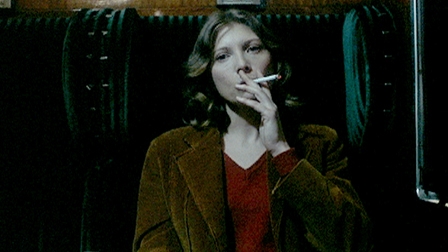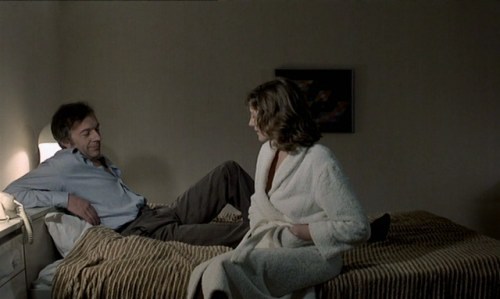This appeared in Take One, July 15, 1979 (vol. 7, no. 8). Check out Dave Kehr’s recent column on 70s Akerman in the New York Times for some other reflections. —J.R.
Chantal Akerman is a tough filmmaker to tangle with, make up one’s mind about or describe. One thing’s clear enough though: Les Rendez-vous d’Anna, her fifth feature, is the most assertive film by a woman that I’ve seen since Marguerite Duras’ Le Camion — and probably the most accessible that Akerman has made to date. It might wind up serving as a calling card for the rest of her work.
A film that assumes the ambition (and pretention) of taking the pulse of Western Europe while pursuing a narcissistic autobiographical meditation obviously isn’t going to win everyone over — particularly when every shot has the visual weight of a battleship and nearly every facial expression has enough glumness to sink one. Take that, Akerman seems to be saying, offering up yet another drab, anonymous hotel room or train station at night, each one lit with precise, uncanny radiance, and hammering these cold, elegantly symmetrical compositions into our skulls with an obstinate will to power that makes Milius and Peckinpah seem like frollicking pussy-cats in comparison. Under the circumstances, whether we like this movie or not is practically irrelevant; it demands to be acknowledged and dealt with as a glittering, grating fact of life.
Like Akerman, whose middle name is Anne, Anna Silver (Aurota Clément) is a Belgian filmmaker in her late twenties who currently lives in Paris. The film covers a three-day trip she takes by train back to Paris from Cologne, where she introduces a film (an event that we don’t see) and picks up Heinrich (Helmut Griem), a schoolteacher whom she later kicks out of her hotel bed.
On her arrival at the Cologne station, she’s met by Ida (Magali Noël) — the mother of a former fiancé whom she has twice changed her mind about marrying.They converse until evening, when Anna boards the Paris train where she talks to a young German who’s moving to Paris (Hans Zieschler). She gets off the train in Brussels, her hometown, where she’s met by her mother (Léa Massari). Instead of going home, where Anna’s ailing father is already asleep, they check into a hotel where Anna, lying naked beside her mother in bed, describes a lesbian affair she has recently become involved in and feels good about.
The next night, arriving in Paris, she’s picked up by her regular boyfriend (Jean-Pierre Cassel), who takes her to still another hotel. Finding him feverish, she takes a cab to a late-night pharmacie to buy him some medicine. Finally returning home — it’s still dark — Anna plays back the recorded phone messages that have come during her absence.
As a plot, this is obviously quite minimal.Each of the “encounters” described above consists mostly of a monologue — by Heinrich, Ida, the German on the train, Anna herself (to her mother), her French lover, Anna again (when she sings him a song), and the voices on her recording machine. In keeping with Akerman’s usual respect for real time, large chunks of this mainly unacted material are simply set down like slabs in front of the viewer without the usual punctuation of camera movements, fades, or dissolves. In a manner recalling Bresson, Antonioni and Straub-Huillet, the locations where these monologues are placed seem featured, lingered over — persisting before, during, after, and even in between the words that are spoken there, constantly threatening to swallow them up.
On the one hand, this reduces the story to a series of on-screen and off-screen meetings that are unified only by their common banality. (“If I have a reputation of being difficult,” Akerman has said, “it’s because I love the everyday and want to present it. In general, people go to the movies precisely to escape the everyday.”) On the other hand, without the compulsive mechanisms of naturalism and suspense operating at their usual levels, Les Rendez-vous d’Anna allows us to purify and examine our own responses rather than simply remain at the mercy of them.
One could argue that Rendez-vous does this less than most of Akerman’s previous features. Whether this represents an about-face or betrayal of her avant-garde origins seems more debatable. Traces of her earlier works are certainly strongly in evidence here — the sheer physical discomfort of bodies cramped in rooms in the non-narrative Hotel Monterey (1972), the picaresque episodic narrative form and the narcissistic self-absorption of Je Tu Il Elle (1974), where Akerman herself played the leading part (in Rendez-vous, she actually speaks the recorded message of Anna’s presumed lover, apparently calling from Italy and speaking in English: “Anna, where are you?”); and obsessive uses of repetition and real time in Jeanne Dielman, 23 Quai de Commerce, 1080 Bruxelles (1976), where the director had an additional hour at her disposal; the preoccupation with exile and urban alienation in News from Home (1977); the centrality of the mother figure in both of the latter films.
Akerman has remarked that Anna can perhaps be seen as a heroine of the future. Maybe she can; but as with Jeanne Dielman, her best film, the questions raised by Rendez-vous are a lot more interesting than the explanations offered by the director in interviews. Why/how are the images so gorgeously luminous and cadaverously creepy at the same time, a form of possession and dispossession that seems to match perfectly Akerman’s relation to her movie, which she uses like a mirror? Is that the way that we use it, too?
Eavesdropping on Anna when she confesses her lesbian affair to her mother (“I wouldn’t dare tell your father–” “Don’t tell him–“), am I moved by identification, sympathy, or voyeurism? What does it have to do with me, in a movie that, as J. Hoberman puts it, orchestrates its shots in a way that renders a musical score superfluous? Is Rendez-vous d’Anna a Buster Keaton film for the 70s without laughs, complete with s-f gadgets, robots, and lonely self-containment, or an old-fashioned European art movie of the 80s? Is it a movie about you (to paraphrase George Landow), or about its maker? All I know is, it looks great and it sure gives me the willies.
— Take One, July 15, 1979 (vol. 7, no. 8)





